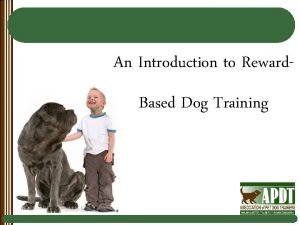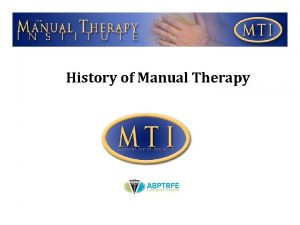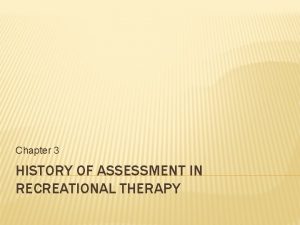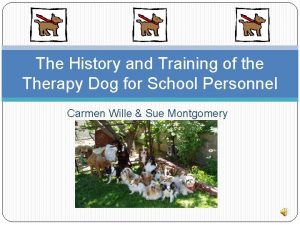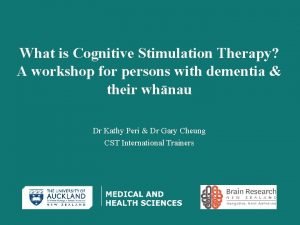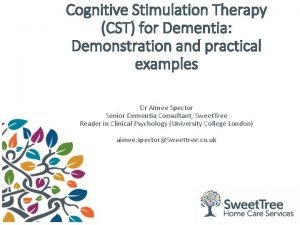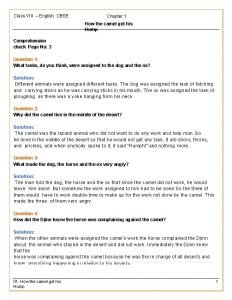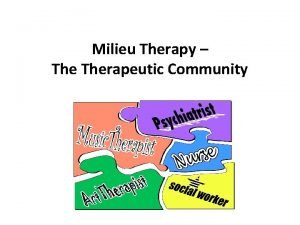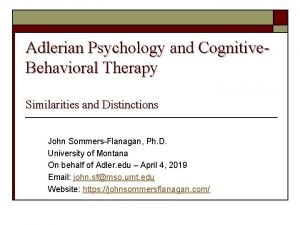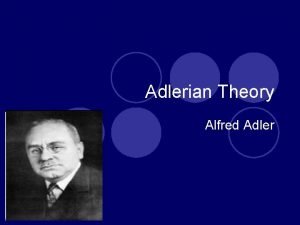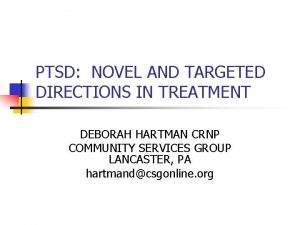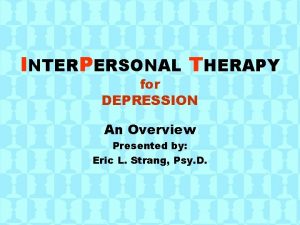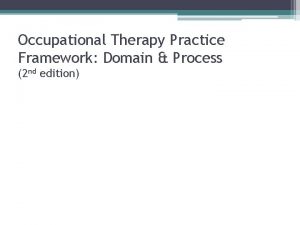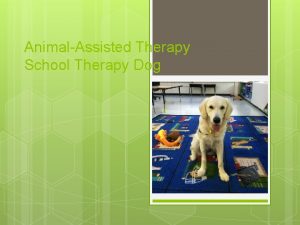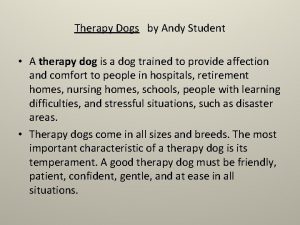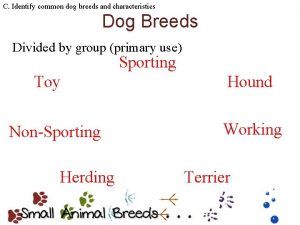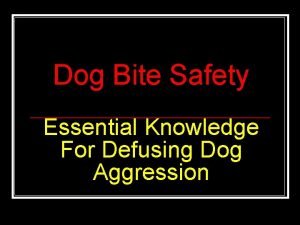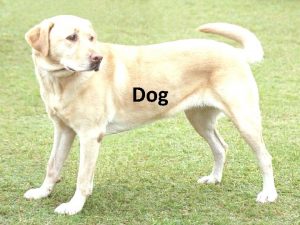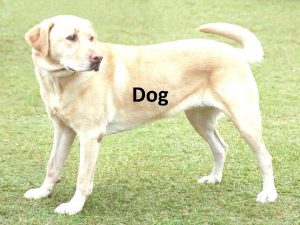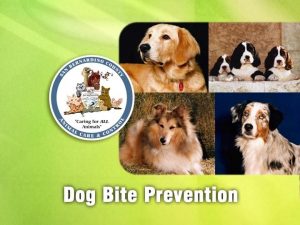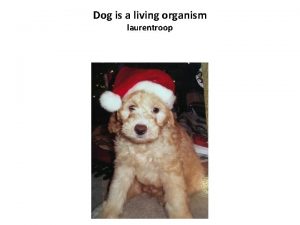The History and Training of the Therapy Dog



































































































- Slides: 99

The History and Training of the Therapy Dog for School Personnel Carmen Wille & Sue Montgomery

Session 1 �Introduction of people and dogs �How participants became interested in dog therapy �Brief history �Benefits �Concerns �Discuss therapy dog organizations �Demonstration of heel, sit, and down �Training

Introductions �Presenters: Carmen Wille and Sue Montgomery �How did you become interested in training a therapy dog? �Our demo dogs: Macy Rou, a Jack Russell Terrier; Ryker, a Border Collie, and Zoey, a Mixed Breed

Dog-assisted Therapy �Dogs used to help alleviate physical, emotional, and social difficulties in children �The Delta Society created the titles Animalassisted Therapy (AAT) and Animal-assisted Activity (AAA). �We are using the title Dog-assisted Therapy. �Our project will provide professionals with important information needed to create their own dog-assisted therapy program at their schools.

Types of Animal-Assisted Therapy �The following animal therapies will be introduced: �Reading-to-dogs- programs �Therapeutic horse riding programs �Animal Assisted Crisis Response (AACR) �Individual and group counseling with animal- assisted therapy �Visiting nursing homes and hospitals �Dolphin assisted therapy, �Assistance/service dogs �Dog-assisted therapy

Reading–to-Dogs-Program �Reading-to-dogs- programs involve having a child read out loud to a dog generally in a library or school setting �Research by University of California, Davis (UCD) who teamed up with All Ears Reading Program found that reading fluency increased by 12% for those students who read to a dog in a public school and increased by 30% for homeschoolers �Benefits include: increased reading enjoyment for children, improved social skills and selfconfidence, decreased absenteeism from school, and increased homework completion

Therapeutic Horse Riding Programs � Therapeutic horse riding generally refers to “mounted activities with people with disabilities …learning traditional or adaptive equestrian skills” (Smith Osborne & Selby, 2010, p. 293) � Benefits include: increased flexibility, balance, motor coordination, and cardio-respiratory function, increased speech and language abilities (Granger and Kogan 2006, citing Biery 1985; Macauley and Gutierrez 2004) � Disadvantages include: the expense of housing, feeding, and caring for a large animal, transporting children to and from the stable often in a rural area, and safety issues if an inappropriate horse is used for therapy (Friesen, 2010, citing Mc. Cowan 1987)

Animal Assisted Crisis Response �Provides trained professionals with a means to reach out and help people affected by a crisis, generally through the use of a dog �AACR teams are not first responders, and they do not search for the injured or dead, instead they provide support and comfort to the victims, friends and family of the victims, and emergency workers (Greenbaum, 2006) �Qualifications for becoming a dog and handler team with the National Animal Assisted Crisis Response are quite involved.

Individual and Group Counseling with Animal-Assisted Therapy �Minatrea and Wesley (2008) found that group participants who were addicted to drugs and received AAT had positive benefits �Improved level of functioning in patients with mood disorders �Animal’s presence created a warm, friendly, safe environment, providing unconditional acceptance, empathy and enhanced creativity during sessions

Visiting Nursing Homes and Hospitals �Different types of animals such as, dogs, cats, rabbits, and birds are taken to nursing homes, whereas generally only certified therapy dogs are taken to hospitals. �Overall research suggests that animals, particularly dogs, seem to have positive benefits on both hospital patients and nursing home residents �Benefits include: decreased tension, depression, anger, fatigue, confusion, and increased vigor

Dolphin-Assisted Therapy � Involves having the client go into the water and interact with the dolphin and its trainer. � Can involve playing, swimming, taking care of the dolphin, watching the dolphin perform tricks, touching the dolphin, and snorkeling with the dolphin (Antonioli & Reveley, 2005) � Research finds that dolphin-assisted therapy can be an effective treatment for mild to moderate depression � Can help children with severe disabilities improve their level of functioning in a shorter period of time than conventional therapies � Disadvantages: high cost of maintaining dolphins, risk of transmitting infections, limited research on the effectiveness of this therapy, risks to the welfare and survival of the dolphin, (Friesen, 2009; Fine, 2006)

Assistance/Service Dogs �A generic term for guide, hearing, or service dog specifically trained to help mitigate the effects of an individual’s disability (Assistance Dogs International, Inc. , 2010) �Types of assistance dogs: guide dogs, hearing dogs, and service dogs � A person must have a disability to qualify for an assistance dog and is protected under the Americans with Disabilities Act (Assistance Dogs of North America, 2010)

Dog-Assisted Therapy �Dog-assisted therapy for the purpose of this paper entails having a certified therapy dog that interacts with students at schools and juvenile facilities �Certified therapy dogs are not legally protected by federal law, and do not have the same protection and rights as a service dog �The therapy dog is usually a family pet, and works with its owner to provide service to others

Benefits of Dog-assisted Therapy Physiological Benefits Reduction in Blood Pressure � Freidmann, Katcher, Thomas, Lynch, and Messent (1983) conducted an experiment to examine the effect that exposure to a dog had on blood pressure and heart rate. � First, researchers introduced half of the participants to a friendly dog. � Then the researchers created three different experiment groups with the first group of children exposed to the dog twice, the second group exposed once, and the third group never exposed. � Immediately after each group, the researchers measured the children’s blood pressure and heart rate. � The children who were exposed to the dog had a greater reduction in blood pressure than the children who were not; with an even greater reduction in blood pressure in children who were exposed twice.

Reduction in Pain �Braun, Stangler, Narveson and Pettingell (2009) conducted an experiment that examined the effect that handling a dog had on pain intensity. �Researchers created two groups: group one monitored pain levels in children between the ages of 3 -17 who were exposed to a dog, and group two monitored pain levels in children who were not exposed. �Results of the experiment revealed that for children who were in pain, handling a dog reduced pain levels. �For children suffering from pain, respiratory rates also increased.

Reduction in Anxiety �Nagengast, Baun, Megel and Leibowitz (1997) researched the outcome of exposing children to a dog during a physical examination. �Children between the ages of 3 and 6 were divided into two groups: In group one, children were exposed to a dog during a physical examination and in group two, children were not exposed. �Researchers determined that in the presence of a dog, children had lower levels of anxiety.

Reduction in Depression �Sockalingam, Li, Krishnadev, Hanson and Balaban (2008) investigated the effect that dog exposure had on individuals with depression. �A 43 -year-old male with a prior diagnosis of bipolar disorder was used. �This individual had recently been assaulted and was experiencing depression, lack of motivation, low self esteem, and somatic complaints. �The man was given a dog to care for on a daily basis. �Results included improved self esteem, increased mood and outlook, decreased anxiety, and improved overall health.

Fewer Illnesses and Increased Health �Charnetski, Riggers, and Brennan (2004) questioned the effect that dog exposure had on overall health. � 58 college students were randomly assigned to one of three groups: group one sat for 18 minutes and petted a dog, group two sat for 18 minutes without a dog, and group three sat for 18 minutes and petted a stuffed animal. � Saliva secretions were collected before and after each group. �Participants who petted the real dog had higher levels of Ig. A in their saliva. �Higher levels of Ig. A in the body are correlated with a reduction in upper respiratory infections.

Social Skills Benefits Increased Social Integration and Relationships �Lanea, Mc. Nicholasb, and Collisb (1998) investigated the benefits of dog exposure and increased social integration. �Fifty-seven physically disabled individuals who received dogs from Dog for the Disabled program were used in this study. �Questionnaires were used to assess the changes in their lives since obtaining the dogs. �Subjects had an increase in social integration and increased health improvement.

Increased Verbal Communication �Lewis (2003), a speech-language pathologist, collected data examining the effects that animalassisted therapy had on communicative skills. �Five preschool children, each lacking in communication skills, were used in this investigation. �Lewis collected data during a six-month interval; three months with a therapy dog and three months without. �Unlike original therapy where only speech services were provided, during the three months that a therapy dog was used, the children’s communicative and receptive skills increased.

Increase Self-esteem �Camp (1997) conducted interviews and observations with five physically disabled individuals who worked with therapy dogs. �She discovered that individuals experience an increase in self-esteem �They also experienced increased independence and security.

Reduction in Behavioral Issues Emotional Disturbance (ED) � Kogan, Granger, Fitchett, Helmer, and Young (1999) researched the effect that Animal–assisted therapy (AAT) dogs had on children who displayed aggressive, negative behaviors. � Once a week for four months two children diagnosed with ED were given the tasks of brushing and teaching various training methods to therapy dogs. � Through these tasks, the boys learned how to use their vocal tones and positive reinforcement to obtain desired results from the dogs. � Both boys displayed a decrease in behavioral problems and angry intonations while displaying more positive relationships with their peers � The first boy also exhibited less distractibility and increased eye contact. � The second boy also exhibited less learned helplessness

Autism � Barol (2006) conducted a single-case study to examine the effect that dog exposure had on social skills in a child with autism. � Once a week for 15 weeks, a five-year-old boy interacted with an eight-year-old dog. � Prior to exposure, the boy was noncompliant and lost interest when asked to play with other children, cut paper using scissors, and play ball with a teacher. � By the third week, Zachary was able to remain intrigued for over twenty minutes while playing ball with Henry, cut dog treats without complaint, and initiate interactions with the dog.

Concerns �There a number of concerns regarding the use of dogs that need to be addressed before the handler starts working with therapy dog. These concerns include zoonotic diseases, allergies, fear of dogs, animal-induced accidents (bites), cultural differences, and the welfare of the dog

Zoonotic Diseases �Diseases and infections naturally transmitted between animals and man. �Waltner-Toews (1993) sent questionnaires to employees at hospitals to determine which zoonotic diseases were of greatest concern. �Rabies, ringworm, and external parasites topped the list. �Even though dogs have the potential to transmit zoonotic diseases, the risk is minimal when safety measures are observed.

Allergies � 5. 3 percent of the United States population has an allergy to animal dander. � Higher percentages for people with a history of asthma. �Symptoms of allergies include: nocturnal wheezy cough, asthma, stuffy nose, and pink eye. �To help reduce allergies, the dog should be bathed and well-groomed. � It is important to know which students have allergies to minimize their contact with therapy dog.

Fear of Dogs �Children may be afraid of dogs through association and bad experiences such as being chased or bitten by a dog. �Allow children to watch others interacting with therapy dog, and allow them plenty of time to become comfortable around the dog. �Give them plenty of room so they may avoid the dog if they choose. �Never insist that children visit with therapy dog.

Animal Induced Accidents (Bites) �Approximately 400, 000 children in the United States seek medical attention for dog bites each year. � When initially bringing therapy dog to a school, it is a good idea to first go over safety rules with the students. �Currently there are no figures that provide the number of dog bites arising from the use of dogs in therapy. �It is believed to be minimal.

Cultural Differences � Brodie et al. , 2002) maintain that some cultures regard dogs as unclean, others view dogs as nuisances, while others believe that spirits may appear as animals. � There are populations who may be uncomfortable being around specific breeds of dogs. � Greenbaum (2006) found that some inner city children do not work well with Pit Bulls, Rottweilers, and Doberman Pinschers, but work well with other breeds, such as a Poodles or Cocker Spaniels. � Care must be taken to respect cultural sensitivities so therapy dog can be a positive addition to the educational environment.

Introduction to Therapy Dog Organizations �Therapy Dogs International (TDI) �Delta Society

Therapy Dogs International (TDI) �A volunteer organization dedicated to regulating, testing and registration of therapy dogs and their volunteer handlers �Largest and oldest (1976) therapy dog organization in the United States �Visit: assisted living communities, private homes, hospitals, libraries, nursing homes, schools, shelters, and funereal homes

Therapy Dogs International �Have: Children’s reading program called Tail Waggin’ Tutor and a disaster stress relief program �Covered by the primary liability insurance policy and secondary volunteer accident insurance if working as a volunteer

Delta Society �National non-profit organization that helps people live healthier and happier lives by incorporating therapy, service and companion animals into their lives � Offers Pet Partners which trains and screens volunteers and their pets so they can visit patients/clients in hospitals, nursing homes, hospice, and physical therapy centers, schools, libraries, and other facilities

Delta Society �Offers resources in animal-assisted therapy for professionals in fields such as healthcare and education �National Service Animal Resource Center provides information and resources for people with disabilities

Time for Demo Dogs �The exercises for today are: �Heel �Sit �Down

Heel �The dog should be walking near the handler, but the dog does not need to be in perfect heel position. �The dog should not pulling on the leash. �The handler should not be dragging the dog along.

Sit �When the sit command is given, the dogs bottom should hit the ground.

Down �When the down command is given, the dogs entire body should by on the ground, both front and back legs.

Training Time �First, let take dogs out to potty and then let’s start training.

Session 2

Session 2 �Dog selection and temperament �Questions/concerns with training �Practice heel, sit, and down �Training equipment/what is allowed in both organizations �Teach stay and practice �Practice heel, sit, down, and stay �Discussion of appearance and grooming �If dogs are ready we will add: accepting a friendly stranger, reaction to distractions, leave-it, and sitting politely

Getting Started in Dog Therapy �Choosing the Correct Dog �Dog Selection �Temperament of Dog

Dog Selection �When selecting a dog for therapy work, it can be either a purebred or a mixed breed �Little research on how to choose a dog �Crowley-Robinson and Blackshaw (1998) found that those who worked near the AAT dog preferred a short-coated animal of medium size that was gentle and placid �Frequently chosen: Labrador Retrievers and Golden Retrievers

Dog Selection Continued �The Delta Society, (1996) a worldwide animal therapy organization, states that the primary selection criteria for therapy dogs are: �Reliability- behavior can be repeated in different situations and with different people �Predictability-Behavior in specific circumstances can be anticipated in advance �Controllability-behavior can be interrupted, guided or managed � Suitability-right animal selected for the right job

Dog Selection Continued �Weiss (2002) believes that dogs need to be evaluated for: � Submission �Fear �Dog aggression �Energy level � If the dog evaluates too high in any of these areas it makes a poor candidate for a therapy dog

Dog Selection Continued Qualities of a Great Therapy Dog �Visits people �Friendly and confident in appearance �Knows how to respect personal boundaries �Completely non-aggressive toward other animals, dogs and people �Initiates contact �Stays engaged �Makes eye contact with people

Temperament of Dog �One of the most important things to consider when selecting a dog for therapy work is the dog’s temperament. �The dog must be friendly, outgoing, tolerant of other dogs and not aggressive toward other pets. �A therapy dog is born not made.

Participant Training Questions/Concerns

Training Time �Let take dogs out to potty and then let’s practice heel, sit, and down.

Training Equipment �The collar should fit correctly, it should not be too loose or too tight. �If the dog is dragging the handler around, it may be time to try a different type of collar. �Buckle collar �Choke chain �Prong collar �Head harness �Martingale �Harness �No pull harness

Training Equipment Allowed by TDI and Delta Society � TDI allows only a plain buckle collar or harness to be used during the evaluation and when making visits as a therapy dog. � Delta Society allows: Premier Gentle Leader Easy-Walk Harness Halti Harness Freedom Harness Sense-ation Harness Sense-ible Harness Body or step-in harnesses (leash clips to a ring on the back of the animal) Buckle, snap, quick-release collars (leather or fabric) Limited slip collars (Martingales), if they do not include metal links Halters/head collars Leashes, no more than 6 feet in length, that are all-leather or all-fabric Metal hardware, such as buckles, slip rings, and D-rings

Let’s teach Stay �When a dog is placed in a sit or down and given the stay command it will remain in that position until released by the handler.

Training Time �Let practice heel, sit, down, and stay.

Appearance and Grooming of Handler and Dog �The handler should always be neat and tidy. �It is helpful to carry a lint brush to remove dog hair from yourself and students. �Always present yourself in a professional and courteous manner. �Realize that many students and staff members will want to say “Hi” to therapy dog. Allow extra time for this. �Always supervise therapy dog. Even when speaking to other students or staff members.

Appearance and Grooming of Handler and Dog �Dog’s hair should be clean and dry. �Any loose hair should be brushed out before a visit. �Dog’s nails should be kept trimmed and not jagged or sharp. �Wipe away any eye discharge with a damp cloth. �Also wipe dog’s face to remove any fine dirt and to freshen the appearance. �Carry a cloth to wipe dirty paws on rainy days before entering a building. �The dog’s therapy bandanna or vest should be clean and dry. �Always carry doggy clean up supplies, if there

Training Time �Let’s try: Accepting a friendly stranger, reactions to distractions, leave it, and sitting politely.

Accepting a Friendly Stranger �This test demonstrates that the dog will allow a friendly stranger to approach it and speak to the handler in a natural, everyday situation. �The evaluator and handler shake hands and exchange pleasantries. �The dog must show no sign of resentment or shyness, and must not break position or try to go to the evaluator.

Reactions to Distractions �This test demonstrates that the dog is confident at all times when faced with common distracting situations, such as the dropping of a large book or a jogger running in front of the dog. �The dog may express a natural interest and curiosity and/or appear slightly startled, but should not panic, try to run away, show aggressiveness, or bark.

Leave It! �The handler with the dog on a loose leash walks over food on the ground and, upon command, the dog should ignore the food. �This exercise tends to take considerable practice, particularly for the chow hound, to become proficient at.

Sitting Politely for Petting �This test demonstrates that the dog will allow a friendly stranger to touch it while it is out with its handler. �The dog should sit at the handler’s side as the evaluator approaches and begins to pet the dog on the head and body only. �The dog may stand in place to accept petting. �The dog must not show shyness or resentment.

Session 3

Session 3 �Discussion of vet care and how that relates to certification of therapy dog �Questions/concerns with training �Review previous exercises: sit, down, stay, heel, accepting a friendly stranger, reaction to distractions, leave-it, and sitting politely �Discussion on registration of therapy dog �Teach with distractions, coming when called, reaction to another dog, reaction to medical equipment, and walking through a crowd �Discussion on identifying stress in the dog

Role of the Veterinarian �The dog needs to be up-to-date on all state required vaccinations, which will include the rabies shot. �The owner needs proof of current vaccinations. �The dog needs to be free of internal parasites, including heartworm. �The dog should be on a monthly heartworm medication. �The dog needs to be free of external parasites, such as fleas and ticks. �The dog needs to pass a vet exam indicating it is healthy.

Role of Veterinarian �The veterinarian plays an important role. �They ensure the dog is up-to-date on vaccinations and free of all parasites and zoonotic diseases to humans. �Delta Society and Therapy Dogs International require paperwork signed by a veterinarian indicating that the dog is healthy for initial certification.

Participant Training Questions/Concerns

Training Time �Let’s review: sit, down, stay, heel, accepting a friendly stranger, reactions to distractions, leave it, and sitting politely.

Registration Requirements for TDI �Have evaluation form showing the 11 tests were passed �Check-up within the past year � Up-to-date rabies vaccination given by a licensed veterinarian and initial series of Distemper, Hepatitis, and Parvovirus vaccinations �Negative Heartworm test done within the past year unless the dog has been on preventative medication or there is no heartworm present in the area

Registration Requirements for TDI �A negative fecal exam must have been done within the last year �A veterinarian must fill out the health form and sign it � Health form, evaluation form, picture of the dog, and the fee to register the dog must be sent in to TDI �The current fee is $10 for 1 dog and 1 handler. �The fee may be higher if there is a fee for site use or the evaluator has to travel a distance

Registration Requirements with Delta Society �Dog must first pass the skills and aptitude evaluation �Seven forms need to be filled out from the registration packet �These forms are: �Photo ID form �Application fee form �Volunteer policies and procedures agreement form �Volunteer review �Handler’s questionnaire �Animal health screening forms �Volunteer contract form

Registration Requirements with Delta Society � Note: the veterinarian needs to fill out and sign the health screening form �The dog must pass a physical exam �Be up-to-date on state required immunization and rabies shot �Must be negative of internal and external parasites �Must have had a negative fecal exam within 6 months �Currently a dog in the Pet Partners Program may not be fed a raw diet

Registration Requirements with Delta Society � Forms need to be sent to Delta Society with the signed team evaluation form, a team photo of the handler and dog, and the required fees within the 90 day expiration date (Delta Society, 2008, 2010). The current fee is $75 for 1 dog and handler.

Training Time �Let’s work on: training with distractions (bouncing ball, toy that walks, heeling with demo dog around dogs on stay, etc. ) coming when called, reaction to another dog, reaction to medical equipment, and walk through a crowd

Training with Distractions �While training an exercise the dog is solidly able to do, slowly add distractions such as the presenter bouncing a ball while the dogs are sit staying, or having a toy that makes noise and walks or heeling the demo dogs around the dogs on a down stay. �Start with mild distractions and increase the level with the dogs’ ability.

Coming When Called �The dog will come when called by the handler. �The handler will walk 10 feet from the dog, turn to face the dog, and call the dog. �The handler may use encouragement to get the dog to come. �Handler’s may choose to tell the dog “stay” or “wait” or they may simply walk away, giving no instructions to the dog as the evaluator provides mild distraction (e. g. , petting)

Reaction to Another Dog �This test demonstrates that the dog can behave politely around other dogs. �Two handlers and their dogs approach each other from a distance of about 10 yards, stop, shake hands, and exchange pleasantries, and continue on for about 5 yards. �The dogs should show no more than a casual interest in each other.

Reaction to Medical Equipment �The dog must be tested around medical equipment (such as wheelchairs, crutches, canes, walkers, or other devices which would ordinarily be found in a facility) to judge the dog’s reactions to common health care equipment.

Walking Through a Crowd �This test demonstrates that a dog can move about politely in pedestrian traffic and is under control in public places. �The dog and handler walk around and pass close to several people (at least three). �The dog may show some interest in the strangers, without appearing overexuberant, shy or resentful. �The handler may talk to the dog and encourage or praise the dog throughout the test. �The dog should not be straining at the leash.

Welfare Considerations of the Dog � The welfare of therapy dog should always be a consideration. � Entering different settings and schedules can be stressful to the dogs. � The handler needs to determine if the dog is coping comfortably to therapy by looking for of stress. � If excessive stress occurs, handlers should give breaks from therapy work or stop altogether.

Identifying Stress in the Dog �Indications of possible stress in the dog �Changes in posture, body movement, head movement, and eye movement from what the dog normally exhibits. �Sweating paws �Salivating �Panting �Yawning �Shaking �Sudden loss of hair �Restlessness

Indications of Stress in the Dog, Continued �Withdrawal �Muscle tenseness �Suspiciousness �Aggression �Hyperalertness �Intensified startle reflex �Ducking behind handler �Self-mutilation �Change in activity or appetite

Stress in the Dog �In order to provide a safe environment for the dog, children need to be taught how to correctly approach, touch, and interact with therapy dog (Jalongo et. al. , 2004). �Always closely supervise children around therapy dog to ensure safety of all parties. �Always monitor the well-being of the dog. �Make sure the dog receives enough exercise and free-time away from therapy work.

Session 4

Session 4 � Discussion of evaluation day � Questions/concerns with training � Review previous exercises: sit, down, heel, stay, accepting a friendly stranger, reaction to distractions, leave-it, sitting politely, teach with distractions, come on a long line, reaction to another dog, reaction to medical equipment, and walk through a crowd � Personal accounts of having a therapy dog in a school setting � Teach clumsy petting, staggering and gesturing, angry yelling and appearance and grooming � Talking to administrators about allowing dog therapy at the school

Evaluation Requirements with TDI �Present proof that the dog is up-to-date on current state required vaccinations and licenses �Dog must be at least a year old and wear a plain collar or harness �Dog must pass the 11 testing requirements �Tester must be certified by TDI

Evaluation Requirements with TDI �The handler must be of good character. �The dog cannot be deaf. �The evaluation begins as soon as the evaluator is able to observe you and your dog on the testing site, well before you begin the evaluation requirements.

Evaluation Requirements with Delta Society �There are four steps to becoming a certified Pet Partners team: 1. Attend a Pet Partners Team Training Course or complete a home-study course 2. Have the health of the animal screened by a veterinarian. 3. Have the handler/animal team evaluated for skills and aptitude (22 exercises need to be passed) 4. Submit the registration application if the animal has been screened as healthy, and the team has passed the evaluation.

Evaluation Requirements with Delta Society �The emphasis is that the dog should be under control all the time. �The training equipment that the animal wears for evaluation, must be used during all therapy dog visits. �Only training equipment approved by Delta Society may be used for the evaluation and later therapy dog visits.

When to Wait Another Day to be Evaluated �If your dog is in season or is pregnant. �Your dog has an infection, open sores, wounds, or stitches. Wait until the animal is healed. �Your dog is on antibiotics and/or anti-fungal medications. �Your dog shows visible signs of not feeling well. A sick dog could pass on a virus or parasite to other animals at the testing site. �You know your dog is not ready yet to pass the exercises.

Participant Training Questions/Concerns

Training Time �Let’s review: sit, down, stay, heel, accepting a friendly stranger, reactions to distractions, leave it, sitting politely, train with distractions, coming when called, reaction to another dog, reaction to medical equipment, and walking through a crowd.

Experiences with Therapy Dogs

Training Time �Time to learn: clumsy petting, staggering and gesturing, angry yelling, and appearance and grooming

Clumsy Petting �The evaluator will approach the dog and awkwardly pet the dog, in such as way that a young child or someone with poor coordination might touch the dog. �The dog should not react negatively, but should tolerate the petting.

Staggering and Gesturing �The assistant staggers, and then moves to normally pet the dog. �The dog may look, but should not react negatively, such as barking or lunging towards the person. �The dog should calmly accept the petting.

Angry Yelling �The assistant yells, then calms down and calls the dog. �The dog should remain calm during the yelling, and not become overly reactive.

Appearance and Grooming �The dog will welcome being groomed and examined and will permit a stranger such as a veterinarian, groomer, or friend of the owner, to do so. �It also demonstrates the owner’s care, concern, and sense of responsibility. �The evaluator inspects the dog, then combs or brushes the dog, and lightly examines the ears and each front foot.

Getting Permission �It is important to talk to administrators and gain their buy-in for a therapy dog at school. �Bring examples of research that talk about the positive benefits of therapy dogs. �Bring proof that the dog is covered by insurance. �Bring therapy dog ID card and a good picture of the dog. �Ask if you can bring the dog in to meet the administrator. �Outline how the dog might be used, for example, in a group for students who have emotional disturbance.

Participant Training Questions/Concerns

The End �Thank you for your participation. �Good luck with evaluation. �Remember to keep practicing the exercises, particularly ones that are more difficult for your dog. �When you are ready for evaluation, look on either of these websites for the nearest testing site. �http: //tdi-dog. org/ �http: //www. deltasociety. org/
 Is this jane's dog yes it is....dog
Is this jane's dog yes it is....dog Therapy dog permission slip
Therapy dog permission slip Suspension therapy for upper limb
Suspension therapy for upper limb Psychoanalytic vs humanistic
Psychoanalytic vs humanistic Bioness integrated therapy system price
Bioness integrated therapy system price Humanistic therapies aim to boost
Humanistic therapies aim to boost Four quadrants dog training
Four quadrants dog training Manual therapy history
Manual therapy history Recreation therapy assessment tools
Recreation therapy assessment tools Temperament
Temperament Cognitive stimulation therapy training course
Cognitive stimulation therapy training course Cognitive stimulation therapy training course
Cognitive stimulation therapy training course Pre trial therapy training
Pre trial therapy training Also history physical
Also history physical Temple family history consultant
Temple family history consultant Hình ảnh bộ gõ cơ thể búng tay
Hình ảnh bộ gõ cơ thể búng tay Lp html
Lp html Bổ thể
Bổ thể Tỉ lệ cơ thể trẻ em
Tỉ lệ cơ thể trẻ em Chó sói
Chó sói Tư thế worm breton
Tư thế worm breton Bài hát chúa yêu trần thế alleluia
Bài hát chúa yêu trần thế alleluia Môn thể thao bắt đầu bằng chữ đua
Môn thể thao bắt đầu bằng chữ đua Thế nào là hệ số cao nhất
Thế nào là hệ số cao nhất Các châu lục và đại dương trên thế giới
Các châu lục và đại dương trên thế giới Công thức tính thế năng
Công thức tính thế năng Trời xanh đây là của chúng ta thể thơ
Trời xanh đây là của chúng ta thể thơ Mật thư tọa độ 5x5
Mật thư tọa độ 5x5 Phép trừ bù
Phép trừ bù độ dài liên kết
độ dài liên kết Các châu lục và đại dương trên thế giới
Các châu lục và đại dương trên thế giới Thể thơ truyền thống
Thể thơ truyền thống Quá trình desamine hóa có thể tạo ra
Quá trình desamine hóa có thể tạo ra Một số thể thơ truyền thống
Một số thể thơ truyền thống Bàn tay mà dây bẩn
Bàn tay mà dây bẩn Vẽ hình chiếu vuông góc của vật thể sau
Vẽ hình chiếu vuông góc của vật thể sau Nguyên nhân của sự mỏi cơ sinh 8
Nguyên nhân của sự mỏi cơ sinh 8 đặc điểm cơ thể của người tối cổ
đặc điểm cơ thể của người tối cổ Thứ tự các dấu thăng giáng ở hóa biểu
Thứ tự các dấu thăng giáng ở hóa biểu Vẽ hình chiếu đứng bằng cạnh của vật thể
Vẽ hình chiếu đứng bằng cạnh của vật thể Phối cảnh
Phối cảnh Thẻ vin
Thẻ vin đại từ thay thế
đại từ thay thế điện thế nghỉ
điện thế nghỉ Tư thế ngồi viết
Tư thế ngồi viết Diễn thế sinh thái là
Diễn thế sinh thái là Dạng đột biến một nhiễm là
Dạng đột biến một nhiễm là Số nguyên là gì
Số nguyên là gì Tư thế ngồi viết
Tư thế ngồi viết Lời thề hippocrates
Lời thề hippocrates Thiếu nhi thế giới liên hoan
Thiếu nhi thế giới liên hoan ưu thế lai là gì
ưu thế lai là gì Sự nuôi và dạy con của hổ
Sự nuôi và dạy con của hổ Khi nào hổ mẹ dạy hổ con săn mồi
Khi nào hổ mẹ dạy hổ con săn mồi Hệ hô hấp
Hệ hô hấp Từ ngữ thể hiện lòng nhân hậu
Từ ngữ thể hiện lòng nhân hậu Thế nào là mạng điện lắp đặt kiểu nổi
Thế nào là mạng điện lắp đặt kiểu nổi Training is expensive without training it is more expensive
Training is expensive without training it is more expensive Metode of the job training
Metode of the job training Aggression replacement training facilitator training
Aggression replacement training facilitator training That you must love me and love my dog summary
That you must love me and love my dog summary Orphan boy and elk dog
Orphan boy and elk dog Persuasive informational text
Persuasive informational text A sexual reproduction
A sexual reproduction The dog barks and the caravan moves on
The dog barks and the caravan moves on Describe how dog horse and ox turned against the man
Describe how dog horse and ox turned against the man Sled dog racing and the 5 themes of geography answer key
Sled dog racing and the 5 themes of geography answer key What is the theme of katie clean
What is the theme of katie clean Sonia kumarii and dog
Sonia kumarii and dog Strip
Strip Ticks and dogs relationship
Ticks and dogs relationship Clean neighbourhoods and environment act 2005 dog fouling
Clean neighbourhoods and environment act 2005 dog fouling Rainforest symbiotic relationship
Rainforest symbiotic relationship Occupational therapy and environmental sustainability
Occupational therapy and environmental sustainability Role of nurse in milieu therapy
Role of nurse in milieu therapy Guidelines for antiplatelet and fibrinolytic therapy
Guidelines for antiplatelet and fibrinolytic therapy Aba therapy billing and insurance services
Aba therapy billing and insurance services Hijama points for female infertility
Hijama points for female infertility Chapter 27 nutritional therapy and assisted feeding
Chapter 27 nutritional therapy and assisted feeding Adlerian theory and cbt
Adlerian theory and cbt Occupational domain
Occupational domain Chapter 28 nutritional support and iv therapy
Chapter 28 nutritional support and iv therapy Chapter 28 nutritional support and iv therapy
Chapter 28 nutritional support and iv therapy Chapter 28 nutritional support and iv therapy
Chapter 28 nutritional support and iv therapy Nutrition and diet therapy nursing
Nutrition and diet therapy nursing Albert adler theory
Albert adler theory Oral placement therapy for speech clarity and feeding
Oral placement therapy for speech clarity and feeding Aba therapy billing and insurance services
Aba therapy billing and insurance services Characteristics of play therapy
Characteristics of play therapy Fraunhofer institute for cell therapy and immunology
Fraunhofer institute for cell therapy and immunology Ptsd
Ptsd Interpersonal therapy
Interpersonal therapy Occupational therapy practice framework domain and process
Occupational therapy practice framework domain and process Usu apply for graduation
Usu apply for graduation Main idea
Main idea Dog man character
Dog man character Parellel structure
Parellel structure Erytherocyte
Erytherocyte Saphenous vein in animals
Saphenous vein in animals Hyperextension
Hyperextension






